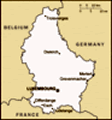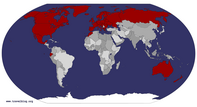Advertisement
Published: June 13th 2016
Early on the morning of December 16, 1944, some alert sentries in the American lines in the area of the Losheim Gap in Belgium heard the low roar of engines. There was some clanking of armored treads. Suddenly large searchlights from the German side were directed up into the low-hanging clouds, reflecting their light downward. In many instances, this revealed to the sleepy Americans that their lines had already been infiltrated by German infantry soldiers, and many died shortly after making the discovery. Germany's Operation Wacht am Rhein ("Watch on the Rhine") had begun, and would develop into the biggest battle the US Army has fought, known to the Allied side as the Battle of the Bulge.
Anyone who is familiar with the Band Of Brothers series knows about the feats and travails of the 101st Airborne Division around Bastogne, and certainly that was important. The "Nuts" response of Col. McAuliffe in response to a German surrender demand will go down as one of the great acts of defiance in the history of warfare. But despite the fact that the 101st fought bravely and preserved control of a critical road junction, they were probably at no time actually outnumbered even
though surrounded. The same is not true for many other actions during the Battle of the Bulge. Bastogne housed a number of journalists prior to the Bulge, and saucy retorts and holding out while surrounded certainly capture the imagination of the public, and these factors mad Bastogne a household name. But equally important were many other places of American resistance. The heroic stand of the 99th Division and critical control of the high ground at Elsenborn Ridge consisted of a division that was outnumbered 5:1 inflicting casualties at a rate of 18:1, and holding the ridge, forcing the Germans to waste time and the precious fuel by turning southward onto inferior roads in their attempt to proceed west toward the Meuse.
In the area of the Losheim Gap, the green 106th Division fought bravely, but these troops had been in place for only a week and were certainly inexperienced, including their commander. By the end of the second day of battle, 7000 men from the division had been marched off into captivity, the largest defeat suffered by the Allies in the European theater. Among the captured was a young Kurt Vonnegut. His experiences as a prisoner held in a
slaughterhouse, and having to help dispose of bodies following the fire-bombing of Dresden, were memorialized in his famous novel
Slaughterhouse Five.
During the first few days of the Battle of the Bulge, the weather was miserable, and flying missions was not possible with the technology of the day. By Christmas Day, the supplies for the surrounded 101st Airborne in and around Bastogne were running thin. They had been rushed into place without proper provisioning, and had cadged ammunition and some other supplies from troops who were in retreat. The Germans did not respect a holiday on Christmas Eve and Christmas Day. They thought the Americans would be homesick and unprepared, and thus prepared what they thought would be a final offensive to take Bastogne. On Christmas Eve, Col McAuliffe went down into a basement where German prisoners were being held. They immediately started jeering at him. When they finally quieted, he told them "I just came to tell you Happy Christmas". Shortly later, the Germans used some of their few remaining aircraft to launch a bombing raid on downtown Bastogne and the American headquarters. Killed in the bombing was a young Belgian woman, Renée Lemaire, who had been volunteering
her service as a "nurse" to the wounded and had become known as the "angel of Bastogne". The next morning the Germans attacked in force around Champs. The battle seesawed back and forth, but eventually the Germans were repulsed after getting perilously close to the last line of defense around Bastogne town. Small amounts of supply materiel had been dropped by C-47's son the 23rd and 24th, but finally on the 26th the weather cleared and large airdrops were accomplished.
On December 19th the American generals met and determined strategy. Patton, always aggressive in attacking, was in favor of an immediate attack against the neck of the Bulge, attempting to trap the German forces behind American lines. As he put it, "The kraut has his head in a sausage grinder and I have my hand on the handle". The decision was made to change Patton's 3rd Army, and in particular his favored 4th Armored Division, away from their eastward attack and turn them northward to relieve Bastogne and constrict the neck of the Bulge. When Patton was asked how long it would take him to disengage from his battle front and turn northward, he replied "48 hours". Bradley replied
"oh, George, don't be fatuous". What they did not know was that Patton had foreseen this eventuality and had ordered his staff to go ahead and start the necessary planning. He was told not to start until the 22nd because they did not feel he could really be ready before then. In three days, performing one of the great military feats of the war, he withdrew the 4th and took it threw the rear of other units and turned it northward. On December 27th, his forward units linked up with elements of the 101st, and re-supply by road began. Patton was lauded as the savior of Bastogne, but the paratroopers there frankly did not feel that they had needed saving. They had broken the backs of the German units sent against them. As one paratrooper famously remarked at the start of the siege of Bastogne, "They've got us surrounded, the poor bastards".
In the end the Bulge was won because brave small units and individuals held up the German advance long enough to allow reinforcements to be brought into the area. The following is descriptive of the sort of thing that was common during the battle:
“While Robertson’s
men streamed south, the 12th SS Panzer Division battered away at the 393rd Infantry and the 3rd Battalion, 23rd Infantry. Around 4:30 p.m., a tank-infantry assault slammed into I Company of the 3rd Battalion. The men, lacking ammunition and bazookas, could not hold. They fell back, covered by Pfc. Richard Cowan, a Kansas native who had been attending Oberlin College when the war broke out. He stayed behind, manning a .30-caliber machine gun as a company-sized force of Germans advanced straight at him with a King Tiger in support. He held his fire until they were at point-blank range and then tore the company apart. Almost half of the eighty or so men in front of Cowan became casualties. The Germans poured fire into his machine gun nest. The King Tiger opened up on him. Three MG-42s unloaded on him. Somebody fired a rocket into his position, but he stayed in the fight, walking his fire back and forth, inflicting tremendous losses on the Germans. Ultimately, he picked up his weapon and withdrew to the 3rd Battalion’s reformed lines to the west, and later made it into Krinkelt. He was killed in action the following day. Cowan’s parents received his
posthumous Medal of Honor from President Harry Truman on the White House lawn a few months later.”
Excerpt From: John R. Bruning. “The Battle of the Bulge.” iBooks. https://itun.es/us/HMygz.l
On December 17, Kampfgruppe Peiper encountered an artillery observation battalion and an ambulance company at Baugnez, just south of Malmedy. Although accounts differ in details, what is clear is that after Peiper himself drove off, 82 men who were standing under guard and unarmed in a field were killed without reason. Many were killed by blows to the head or gunshot wounds delivered from such close range as to leave powder burns. There were also survivors who made it to American positions at Malmedy and told the tale of the massacre. Some of you may have heard that Charles Durning (the actor who played the crooked cop in The Sting) was a Malmedy survivor, but that is almost certainly not the case. In addition to the Baugnez killings, Kempfgruppe Peiper was responsible for dozens of unwarranted civilian executions at places such as Stoumont and Stavelot. In the end, two days after Baugnez, the remaining 700 men from Peiper's original 3000 had to leave their fuel-less vehicles at
La Gleize and start the long walk back home.
Today we started at the Luxembourg American Cemetery, where 5076 Americans who died in and around the Bulge area are interred. At their head, now as in war, is Gen. George Patton. Named military governor of Bavaria, his remarks on denazification resulted in his firing, and he was made head of the 15th Army, which was a small unit writing the history of the war. On his way to a pheasant hunt in December 1945, he hit his head in a low-speed automobile accident and suffered a C3-C4 spinal fracture/dislocation resulting in paralysis. He died 12 days later. He is interred in a place of honor near the plaza of the cemetery.
We then headed up into the Malmedy/Stavelot/Trois-Pont/La Gleize area, more or less following the route taken by Kampfgruppe Peiper, including the massacre site at Baugnez Crossroads (commonly, although somewhat inaccurately, called the Malmedy massacre). It rained off and on all day, and we could not get into the two small museums we wished to see due to their Monday closings, so it was a short day ending in a return to our Luxembourg hotel.
Advertisement
Tot: 0.054s; Tpl: 0.013s; cc: 7; qc: 24; dbt: 0.0214s; 1; m:domysql w:travelblog (10.17.0.13); sld: 1;
; mem: 1.1mb










